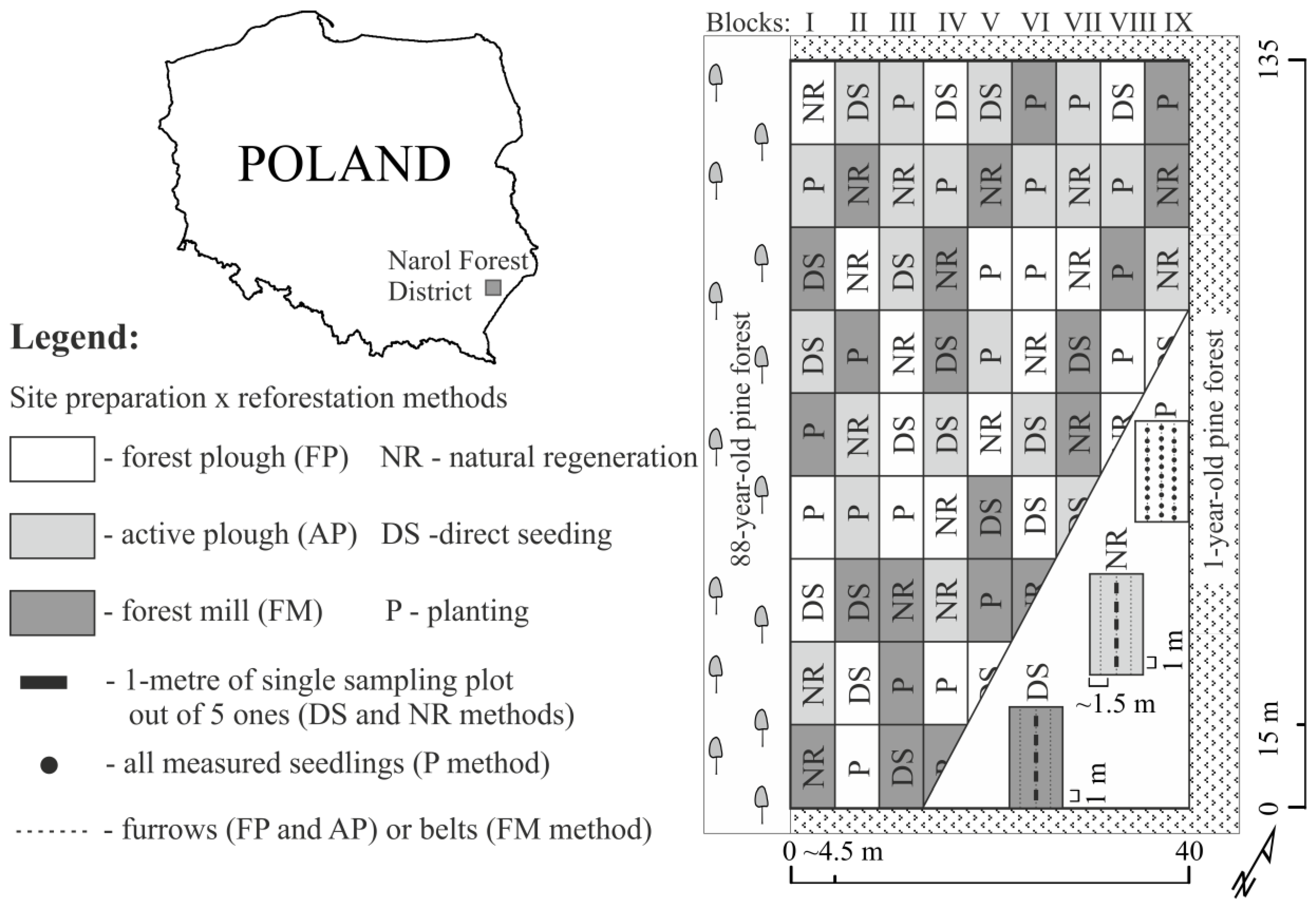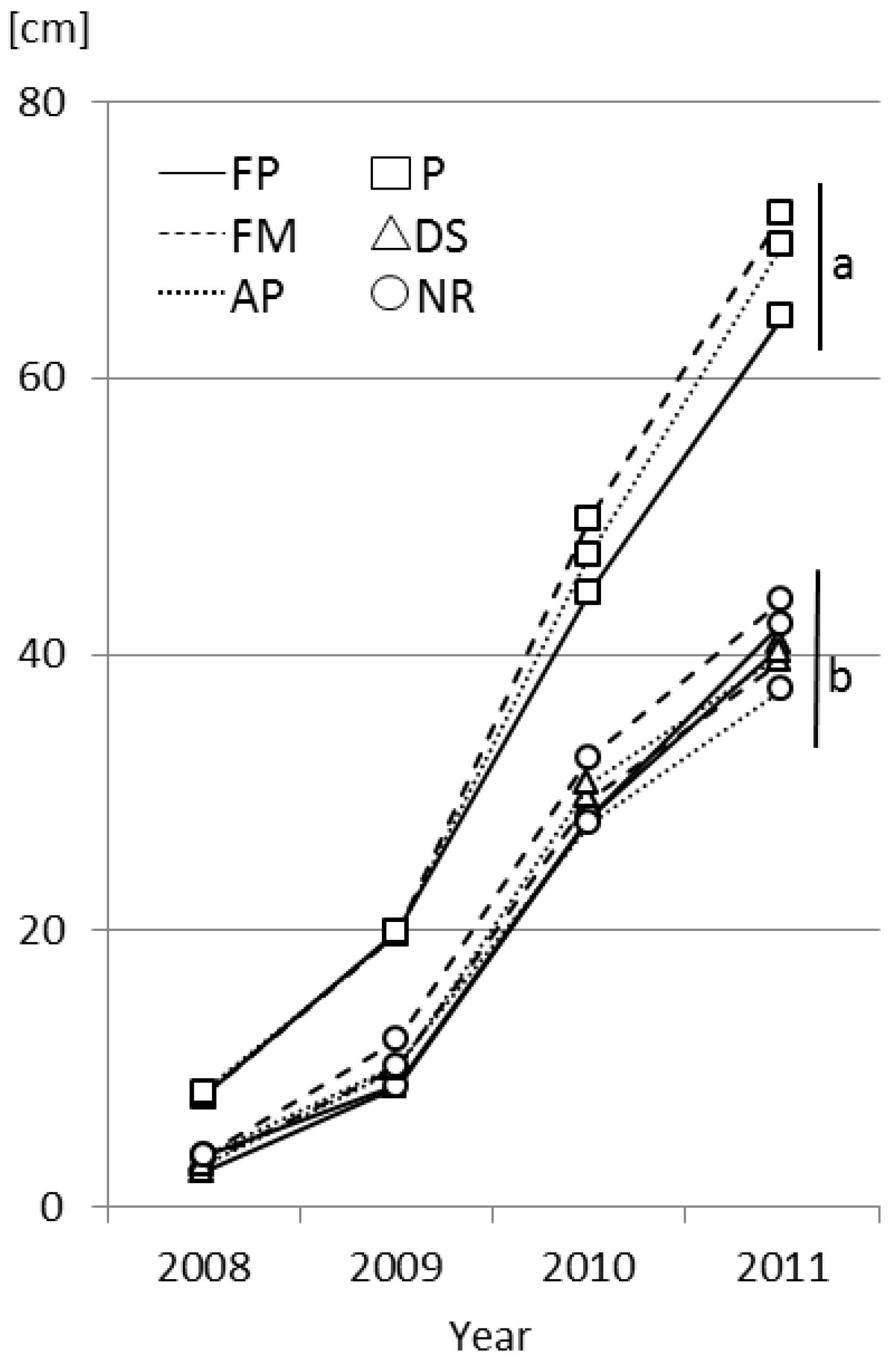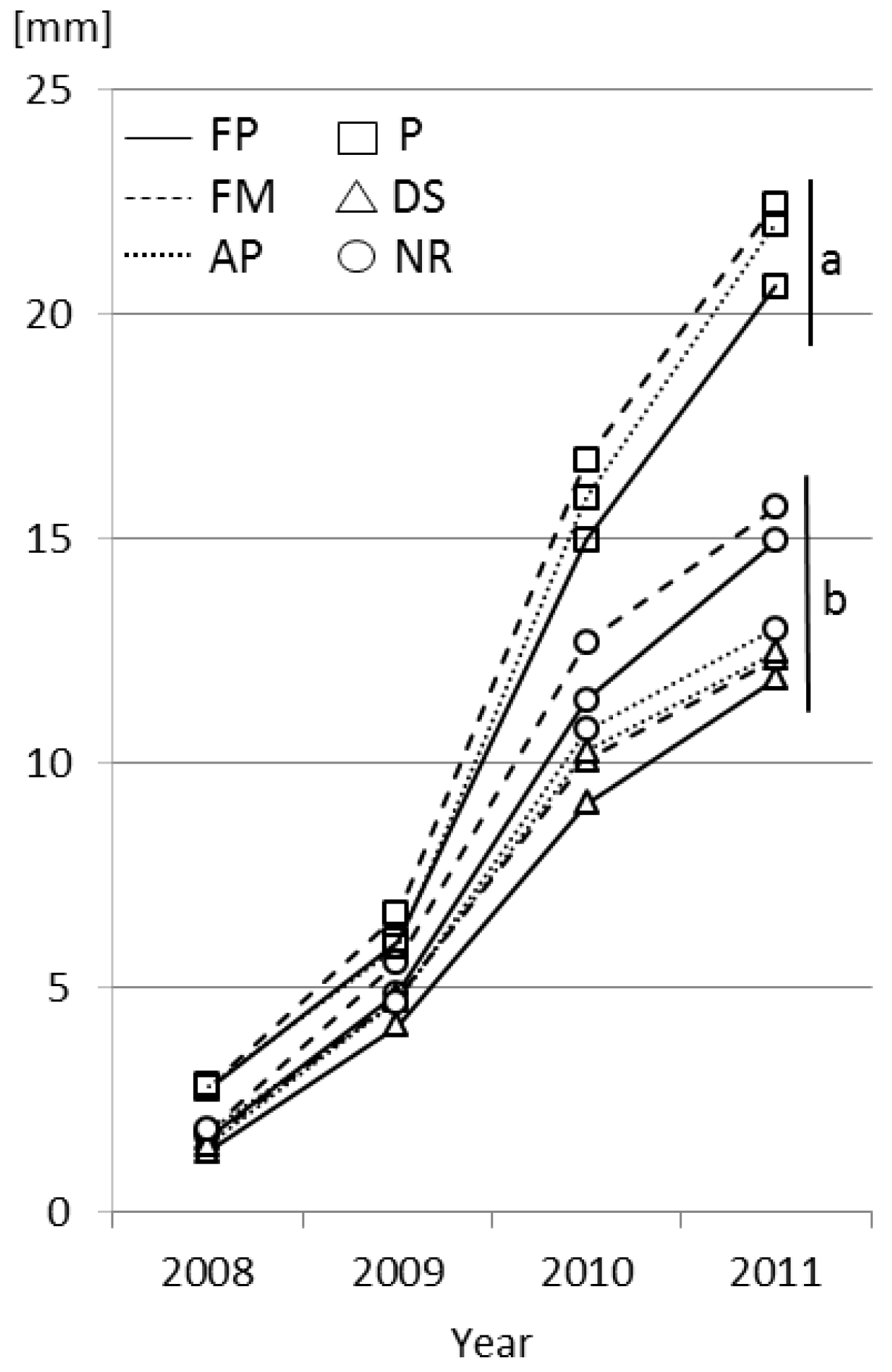Effects of Reforestation and Site Preparation Methods on Early Growth and Survival of Scots Pine (Pinus sylvestris L.) in South-Eastern Poland
Abstract
:1. Introduction
2. Materials and Methods
2.1. Study Area
2.2. Weather Conditions
2.3. Experimental Design and Treatments
2.4. Measurements
2.5. Statistical Analysis
3. Results
4. Discussion
5. Conclusions
Supplementary Materials
Acknowledgments
Author Contributions
Conflicts of Interest
References
- Krakau, U.K.; Liesebach, M.; Aronen, T.; Lelu-Walter, M.A.; Schneck, V. Scots Pine (Pinus sylvestris L.). In Forest Tree Breeding in Europe; Pâques, L., Ed.; Managing forest ecosystems, Springer: Dordrecht, The Netherlands, 2013; Volumn 25, pp. 267–323. ISBN 978-94-007-6145-2. [Google Scholar]
- Principles of Silviculture in Poland; Information Center of Polish State Forests: Warsaw, Poland, 2012; p. 72. ISBN 978-83-61633-65-5. Available online: http://www.lasy.gov.pl/pl/pro/publikacje/copy_of_gospodarka-lesna/hodowla/zasady-hodowli-lasu-dokument-w-opracowaniu/view (accessed on 2 November 2017).
- Report on the State of Forest in Poland 2015. Available online: http://www.lasy.gov.pl/informacje/publikacje/informacje-statystyczne-i-raporty/raport-o-stanie-lasow/raport-o-stanie-lasow-2015/view (accessed on 2 September 2015).
- Mattsson, L.; Li, C.-Z. The non-timber value of northern Swedish Forest—An economic analysis. Scand. J. For. Res. 1993, 8, 426–434. [Google Scholar] [CrossRef]
- Tomczyk, S. Odnowienie Naturalne. Sosna; Biblioteczka leśniczego, Wydawnictwo Świat: Warsaw, Poland, 1993; Volumn 29, p. 23. [Google Scholar]
- Sobczak, R. Siew pod przykryciem—nowy sposób zakładania upraw leśnych w Finlandii. Las Polski 1984, 2, 24–25. [Google Scholar]
- Bernadzki, E. Wybrane problemy uprawy. In Biologia Sosny Zwyczajnej; Białobok, S., Boratyński, A., Bugała, W., Eds.; Sorus: Poznań-Kórnik, Poland, 1993; pp. 409–441. ISBN 83-85599-21-5. [Google Scholar]
- Wennström, U.; Bergsten, U.; Nilsson, J.-E. Mechanized microsite preparation and direct seedlings of Pinus sylvestris in boreal forests—a way to create desired sparing at low cost. New For. 1999, 18, 179–198. [Google Scholar] [CrossRef]
- Mäkitalo, K. Effect of site preparation and reforestation method on survival and height growth of Scots pine. Scand. J. For. Res. 1999, 14, 512–525. [Google Scholar] [CrossRef]
- De Chantal, M.; Leinonen, K.; Ilvesniemi, H.; Westman, C.J. Combined effects of site preparation, soil properties, and sowing date on the establishment of Pinus silvestris and Picea abies from seeds. Can. J. For. Res. 2003, 33, 931–945. [Google Scholar] [CrossRef]
- Willoughby, I.; Jinks, R.L.; Kerr, G.; Gosling, P.G. Factors affecting the success of direct seeding for lowland afforestation in the UK. Forestry 2004, 77, 467–482. [Google Scholar] [CrossRef]
- Holgén, P.; Hånell, B. Performance of planted and naturally regenerated seedlings in Picea abies-dominated shelterwood stands and clearcuts in Sweden. For. Ecol. Manag. 2000, 127, 129–138. [Google Scholar] [CrossRef]
- Hyytiäinen, K.; Ilomäki, S.; Mäkelä, A.; Kinnunen, K. Economic analysis of stand establishment for Scots pine. Can. J. For. Res. 2006, 36, 1179–1189. [Google Scholar] [CrossRef]
- Löf, M.; Dey, D.C.; Navarro, R.M.; Jacobs, D.F. Mechanical site preparation for forest restoration. New For. 2012, 43, 825–848. [Google Scholar] [CrossRef]
- Nilsson, U.; Örlander, G. Vegetation management on grass-dominated clearcuts planted with Norway spruce in southern Sweden. Can. J. For. Res. 1999, 29, 1015–1026. [Google Scholar] [CrossRef]
- Petersson, M.; Örlander, G. Effectiveness of combinations of shelterwood, scarification, and feeding barriers to reduce pine weevil damage. Can. J. For. Res. 2003, 33, 64–73. [Google Scholar] [CrossRef]
- Steijlen, I.; Nilsson, M.-C.; Zackrisson, O. Seed regeneration of Scots pine in boreal forest stand dominated by lichen and feather moss. Can. J. For. Res. 1995, 25, 713–723. [Google Scholar] [CrossRef]
- Jäderlund, A.; Norberg, G.; Zackrisson, O.; Dahlberg, A.; Teketay, D.; Dolling, A.; Nilsson, M.C. Control of bilberry vegetation by steam treatment—Effects on seeded Scots pine and associated mycorrhizal fungi. For. Ecol. Manag. 1998, 108, 275–285. [Google Scholar] [CrossRef]
- Archibold, O.W.; Acton, C.; Ripley, E.A. 2000 Effect of site preparation on soil properties and vegetation cover, and the growth and survival of white spruce (Picea glauca) seedlings, in Saskatchewan. For. Ecol. Manag. 2000, 131, 127–141. [Google Scholar] [CrossRef]
- Block, M.D.; Van Rees, K.C.J. Mechanical site preparation impacts on soil properties and vegetation communities in the Northwest Territories. Can. J. For. Res. 2002, 32, 1381–1392. [Google Scholar]
- MacKenzie, M.D.; Schmidt, M.G.; Bedford, L. Soil microclimate and nitrogen availability 10 years after mechanical site preparation in northern British Columbia. Can. J. For. Res. 2005, 35, 1854–1866. [Google Scholar] [CrossRef]
- Heiskanen, J.; Mäkitalo, K.; Hyvönen, J. Long-term influence of site preparation on water-retention characteristics of forest soil in Finnish Lapland. For. Ecol. Manag. 2006, 241, 127–133. [Google Scholar] [CrossRef]
- Alcázar, J.; Rothwell, L.R.; Woodard, M.P. Soil disturbance and the potential for erosion after mechanical site preparation. North. J. Appl. For. 2002, 19, 5–13. [Google Scholar]
- Löf, M.; Gemmel, U.; Nilsson, U.; Welander, N.T. The influence of site preparation on growth in Quercus robur L. seedlings in a southern Sweden clear-cut and shelterwood. For. Ecol. Manag. 1998, 109, 241–249. [Google Scholar] [CrossRef]
- Edeso, J.M.; Merino, A.; González, M.J.; Marauri, P. Soil erosion under different harvesting managements in steep forestlands from northern Spain. Land Degrad. Dev. 1998, 10, 79–88. [Google Scholar] [CrossRef]
- Munson, A.D.; Timmer, V.R. Soil nitrogen dynamics and nutrition of pine following silvicultural treatments in boreal and Great Lakes—St. Lawrence plantations. For. Ecol. Manag. 1995, 76, 169–179. [Google Scholar] [CrossRef]
- Wallertz, K.; Malmqvist, C. The effect of mechanical site preparation methods on the establishment of Norway spruce (Picea abies (L.) Karst.) and Douglas fir (Pseudotsuga menziesii (Mirb.) Franco) in southern Sweden. Forestry 2013, 86, 71–78. [Google Scholar] [CrossRef]
- Sutton, R.F. Mounding site preparation: A review of European and North American experience. New For. 1993, 7, 151–192. [Google Scholar] [CrossRef]
- Bedford, L.; Sutton, R.F. Site preparation for establishing lodgepole pine in the sub-boreal spruce zone of interior British Columbia: The Bednesti trial, 10-year results. For. Ecol. Manag. 2000, 126, 227–238. [Google Scholar] [CrossRef]
- Neugebauer, Z. Poradnik Dla Operatorów Maszyn Leśnych Agregowanych Na Ciągnikach; Dyrekcja Generalna Lasów Państwowych: Warsaw-Bedoń, Poland, 2008; p. 249.
- Prévost, M. Effects of scarification on seedbed coverage and natural regeneration after a group seed-tree cutting in a black spruce (Picea mariana) stand. For. Ecol. Manag. 1997, 94, 219–231. [Google Scholar] [CrossRef]
- Mattsson, S.; Bergsten, U. Pinus contorta growth in northern Sweden as affected by soil scarification. New For. 2003, 26, 217–231. [Google Scholar] [CrossRef]
- Nordborg, F.; Nilsson, U. Growth, damage and net nitrogen uptake in Picea abies (L.) Karst. seedlings: Effects of site preparation and fertilization. Ann. For. Sci. 2003, 60, 657–666. [Google Scholar] [CrossRef]
- Bilodeau-Gauthier, S.; Paré, D.; Messier, C.; Bélanger, N. Juvenile growth of hybrid poplars on acid boreal soil determined by environmental effects of soil preparation, vegetation control, and fertilization. For. Ecol. Manag. 2011, 261, 620–629. [Google Scholar] [CrossRef] [Green Version]
- Boateng, J.O.; Heineman, J.L.; McClarnon, J.; Bedford, L. Twenty year responses of white spruce to mechanical site preparation and early chemical release in the boreal region of northeastern British Columbia. Can. J. For. Res. 2006, 36, 2386–2399. [Google Scholar] [CrossRef]
- Pigan, I. Wpływ sposobu przygotowania gleby na stan upraw sosnowych w warunkach siedlisk wilgotnych. Sylwan 2009, 153, 745–757. [Google Scholar]
- Pigan, I. Odnowienie naturalne sosny (Pinus sylvestris L.) na siedliskach wilgotnych przy zastosowaniu różnych metod przygotowania gleby. Sylwan 2010, 154, 524–534. [Google Scholar]
- Aleksandrowicz-Trzcińska, M.; Drozdowski, S.; Brzeziecki, B.; Rutkowska, P.; Jabłońska, B. Effect of different methods of site preparation on natural regeneration of Pinus sylvestris in eastern Poland. Dendrobiol. 2014, 71, 73–81. [Google Scholar] [CrossRef]
- Managements Plans for Narol Forest District for years 2003–2012: Stands description data. An internal document for Narol Forest District elaborated by Bureau for Forest Management and Geodesy in Przemyśl, Poland. 2003.
- De Martonne, E. Une nouvelle fanction climatologique: L’indice d’aridité. La Météoroligie 1926, 2, 449–458. [Google Scholar]
- Hounam, C.E.; Burgos, J.J.; Kalik, M.S.; Palmer, W.C.; Rodda, J. Drought and Agriculture; Report of the Commission for Agricultural Meteorology Working Group on Assessment of Drought; Technical Note No. 138; WMO Publication No. 392; World Meteorological Organization: Geneva, Switzerland, 1975; p. 127. [Google Scholar]
- Pinheiro, J.; Bates, D.; DebRoy, S.; Sarkar, D.; R Development Core Team. Nlme: Linear and Nonlinear Mixed Effects Models, R Package Version 3.1-109; 2013. Available online: https://CRAN.R-project.org/package=nlme (accessed on 2 November 2017).
- Collet, C.; Moguedec, G. Individual seedling mortality as a function in naturally regenerated beech seedlings. Forestry 2007, 80, 359–370. [Google Scholar] [CrossRef]
- Heiskanen, J.; Rikala, R. Root growth and nutrient uptake of Norway spruce container seedlings planted in mounded boreal forest soil. For. Ecol. Manag. 2006, 222, 410–417. [Google Scholar] [CrossRef]
- Thiffault, N.; Jobidon, R.; Munson, A.D. Performance and physiology of large containerized and bare-root spruce seedlings in relation to scarification and competition in Québec (Canada). Ann. For. Sci. 2003, 60, 645–655. [Google Scholar] [CrossRef]
- Sewerniak, P.; Gonet, S.S.; Quaium, M. Wpływ przygotowania gleby frezem leśnym na wzrost sadzonek sosny zwyczajnej w warunkach ubogich siedlisk Puszczy Bydgoskiej. Sylwan 2012, 156, 871–880. [Google Scholar]
- Nordborg, F.; Nilsson, U.; Gemmel, P.; Örlander, G. Carbon and nitrogen stocks in soil, trees and field vegetation in conifer plantations 10 years after deep soil cultivation and patch scarification. Scand. J. For. Res. 2006, 21, 356–363. [Google Scholar] [CrossRef]
- Löf, M.; Rydberg, D.; Bolte, A. Mounding site preparation for forest restoration: Survival and short term growth response in Quercus robur L. seedlings. For. Ecol. Manag. 2006, 232, 19–25. [Google Scholar] [CrossRef]
- Béland, M.; Agestam, E.; Ekö, P.M.; Gemmel, P.; Nilsson, U. Scarification and seedfall affects natural regeneration of Scots pine under two shelterwood densities and clear-cut in southern Sweden. Scand. J. For. Res. 2000, 15, 247–255. [Google Scholar] [CrossRef]
- Agestam, E.; Ekö, P.M.; Nilsson, U.; Welander, N.T. The effects of shelterwood density and site preparation on natural regeneration of Fagus sylvatica in southern Sweden. For. Ecol. Manag. 2003, 176, 61–73. [Google Scholar] [CrossRef]
- Oleskog, G.; Sahlén, K. Effect of seedbed substrate on moisture conditions and germination of Pinus sylvestris (L.) seeds in clear-cut. Scan. J. For. Res. 2000, 15, 225–236. [Google Scholar] [CrossRef]
- De Chantal, M.; Leinonen, K.; Ilvesniemi, H.; Westman, C.J. Effects of site preparation on soil properties and on morphology of Pinus silvestris and Picea abies seedlings sown at different dates. New For. 2004, 27, 159–173. [Google Scholar] [CrossRef]
- Ruano, I.; Pando, V.; Bravo, F. How do Ligot and water influence Pinus pinaster Ait. germination and early seedling development? For. Ecol. Manag. 2009, 258, 2647–2653. [Google Scholar] [CrossRef]
- Rodriguez-Garcia, E.; Grater, G.; Bravo, F. Climatic variability and Rother site factor influence on natural regeneration of Pinus pinaster Ait. in Mediterranean forests. Ann. For. Sci. 2011, 68, 811–823. [Google Scholar] [CrossRef]
- Andrzejczyk, T.; Drozdowski, S. Rozwój naturalnego odnowienia sosny zwyczajnej na powierzchni przygotowanej pługiem dwuodkładnicowym. Sylwan 2003, 5, 28–35. [Google Scholar]
- Pardos, M.; Montes, F.; Aranda, I.; Cañellas, I. Influence of environmental conditions on germinant survival and diversity of Scots pine (Pinus sylvestris L.) in central Spain. Eur. J. Forest. Res. 2007, 126, 37–47. [Google Scholar] [CrossRef]
- Puhlick, J.J.; Laughlin, D.C.; Moor, M.M. Factors influencing ponderosa pine regeneration in the southwestern USA. For. Ecol. Manag. 2012, 264, 10–19. [Google Scholar] [CrossRef]
- Erefur, C.; Bergsten, U.; de Chantal, M. Establishment of direct seeded seedlings of Norway spruce and Scots pine: Effects of stand conditions, orientation and distance with respect to shelter tree, and fertilization. For. Ecol. Manag. 2008, 255, 1186–1195. [Google Scholar] [CrossRef]
- Nilson, M.E.; Hjältén, J. Covering pine-seeds immediately after seeding: Effect on seedling emergence and on mortality through deed-predation. For. Ecol. Manag. 2003, 176, 449–457. [Google Scholar] [CrossRef]
- Oleskog, G.; Grip, H.; Bergsten, U.; Sahlén, K. Seedling emergence of Pinus sylvestris in characterized seedbed substrates under different moisture conditions. Can. J. For. Res. 2000, 30, 1766–1777. [Google Scholar] [CrossRef]
- Bergsten, U. Temperature tolerance of invigorated seeds of Pinus sylvestris L., and Picea abies (L.) Karst. using TTGP-test. For. Suppl. 1989, 62, 107–115. [Google Scholar]
- Drozdowski, S. Wpływ różnych sposobów odnowienia naturalnego na wyniki odnowienia naturalnego sosny zwyczajnej (Pinus sylvestris L.). Acta Sci. Pol. Silv. Col. Ratio Ind. Lign. 2002, 1, 27–34. [Google Scholar]
- Karlsson, M.; Nilsson, U. The effects of scarification and shelterwood treatments on naturally regenerated seedlings in southern Sweden. For. Ecol. Manag. 2005, 205, 183–197. [Google Scholar] [CrossRef]
- Akashi, N. Dispersion pattern and mortality of seeds and seedlings of Fagus crenata Blume in a cool temperate forest in western Japan. Ecol. Res. 1997, 12, 159–165. [Google Scholar] [CrossRef]
- Wennström, U.; Bergsten, U.; Nilsson, J.-E. Seedling establishment and growth after direct seeding with Pinus sylvestris: Effects of seed type, seed origin, and seeding year. Silva Fennica 2007, 41, 299–314. [Google Scholar] [CrossRef]




| Month | Temperature (°C) | Precipitation (mm) | Aridity Index | |||||||||
|---|---|---|---|---|---|---|---|---|---|---|---|---|
| 2008 | 2009 | 2010 | 2011 | 2008 | 2009 | 2010 | 2011 | 2008 | 2009 | 2010 | 2011 | |
| April | 8.9 | 10.5 | 8.9 | 9.8 | 60 | 8 | 27 | 38 | 38.1 | 4.7 | 17.1 | 23 |
| May | 12.9 | 12.7 | 14.3 | 13.5 | 94 | 94 | 122 | 34 | 49.3 | 49.7 | 60.2 | 17.4 |
| June | 17.2 | 16.1 | 17.7 | 17.6 | 39 | 82 | 72 | 62 | 17.2 | 37.7 | 31.2 | 27 |
| July | 17.7 | 19 | 20 | 18.2 | 104 | 33 | 109 | 141 | 45.1 | 13.7 | 43.6 | 60 |
| August | 18.3 | 17.4 | 19 | 18 | 82 | 40 | 74 | 49 | 34.8 | 17.5 | 30.2 | 21 |
| September | 12.3 | 14.1 | 11 | 14 | 95 | 32 | 96 | 23 | 51.1 | 15.9 | 54.9 | 11.5 |
| October | 9.7 | 7.6 | 4.5 | 6.6 | 42 | 91 | 13 | 21 | 25.6 | 62 | 10.8 | 25.2 |
| Treatment | Average Density (Seedlings ha−1) in Year | |||
|---|---|---|---|---|
| 2008 | 2009 | 2010 | 2011 | |
| Planting FP | 9651 (1.8) c | 9602 (1.9) c | 9536 (1.7) c | 9536 (1.7) c |
| FM | 9766 (0.9) c | 9717 (1.1) c | 9618 (1.6) c | 9569 (2.2) c |
| AP | 9668 (1.3) c | 9634 (1.7) c | 9420 (3.1) c | 9371 (3.2) c |
| Direct seeding FP | 61,809 (46.4) a,b | 54,101 (54.9) a,b | 50,396 (56.6) a,b | 47,876 (59.6) a,b |
| FM | 46,838 (26.8) b | 42,243 (27.8) b | 38,982 (28.2) b | 36,907 (30.9) b |
| AP | 70,850 (29.1) a | 65,218 (31.2) a | 60,771 (34.2) a | 58,251 (39.9) a |
| Natural regeneration FP | 11,265 (77.9) c | 9783 (94.0) c | 9190 (86.8) c | 8449 (83.6) c |
| FM | 6077 (58.2) c | 4743 (61.5) c | 4743 (61.5) c | 4447 (63.6) c |
| AP | 19,417 (73.9) c | 16,008 (76.7) c | 14,526 (66.3) c | 13,488 (64.2) c |
| Mechanical Site Preparation Method | Relative Abundance (%) of Seedlings That Emerged in Year | Density Including Self-Sown Seedlings That Germinated in Second Year (Seedlings ha−1) 1 | Survival Rate (%) of Seedlings That Germinated in Second Year 2 | ||||
|---|---|---|---|---|---|---|---|
| 2008 | 2009 | 2009 | 2010 | 2011 | 2010 | 2011 | |
| FP | 100 | 100 | 75,593 (58.2) a | 62,550 (58.6) a | 41,058 (60.8) a | 81.1 (15.3) a | 49.6 (37.8) a |
| FM | 53 | 27 | 22,826 (68.7) c | 18,528 (81.5) c | 12,302 (93.2) c | 76.2 (26.1) a | 43.4 (34.8) a |
| AP | 172 | 45 | 46,097 (86.7) b | 37,648 (83.8) b | 24,160 (82.0) b | 76.9 (18.8) a | 35.5 (63.3) a |
© 2017 by the authors. Licensee MDPI, Basel, Switzerland. This article is an open access article distributed under the terms and conditions of the Creative Commons Attribution (CC BY) license (http://creativecommons.org/licenses/by/4.0/).
Share and Cite
Aleksandrowicz-Trzcińska, M.; Drozdowski, S.; Wołczyk, Z.; Bielak, K.; Żybura, H. Effects of Reforestation and Site Preparation Methods on Early Growth and Survival of Scots Pine (Pinus sylvestris L.) in South-Eastern Poland. Forests 2017, 8, 421. https://doi.org/10.3390/f8110421
Aleksandrowicz-Trzcińska M, Drozdowski S, Wołczyk Z, Bielak K, Żybura H. Effects of Reforestation and Site Preparation Methods on Early Growth and Survival of Scots Pine (Pinus sylvestris L.) in South-Eastern Poland. Forests. 2017; 8(11):421. https://doi.org/10.3390/f8110421
Chicago/Turabian StyleAleksandrowicz-Trzcińska, Marta, Stanisław Drozdowski, Zbigniew Wołczyk, Kamil Bielak, and Henryk Żybura. 2017. "Effects of Reforestation and Site Preparation Methods on Early Growth and Survival of Scots Pine (Pinus sylvestris L.) in South-Eastern Poland" Forests 8, no. 11: 421. https://doi.org/10.3390/f8110421




